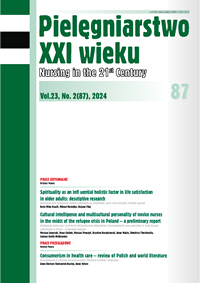Assessment of workload and pain in hospital workers using the Standardized Nordic Questionnaire -NMQ during the COVID-19 pandemic – a cross-sectional study
DOI:
https://doi.org/10.2478/pielxxiw-2024-0023Keywords:
medical workers, occupational diseases, WRMSD, NMQ, COVID-19Abstract
ASSESSMENT OF WORKLOAD AND PAIN IN HOSPITAL WORKERS USING THE STANDARDIZED NORDIC QUESTIONNAIRE -NMQ DURING THE COVID-19 PANDEMIC – A CROSS-SECTIONAL STUDY
Aim. The aim of the study was to show the degree of advancement of pain and social problems of medical employees.
Material and methods. The study was conducted in one of the hospitals in Lesser Poland. A cross-sectional study was conducted from 1.11.2021 to 31.01.2022. The study group consisted of 106 participants (93 (87.7%) women and 13 (12.3%) men) from hospital wards, emergency ambulance stations, administrative employees and an analytical laboratory. The Standardized Nordic Questionnaire in the Polish version – NMQ survey was used to survey employees. The survey was conducted during the SARS-CoV-2 pandemic, and respondents were included in the research voluntarily.
Results. Pain in the last 7 days was confirmed by 65% of the respondents, in more than 65% of the respondents the pain occurs during rest and sleep. In 64% of the subjects, pain was present on both sides of the body. The greatest pain was related to the lumbar spine in 54% of the respondents. The average pain is almost 5.35 on the Visual Analog Scale – VAS scale.
Conclusions. The COVID-19 pandemic may have had a negative impact on the physical and mental condition of medical workers. Work Related Musculoskeletal Disorders - WRMSD ailments are common and are a serious, constantly growing problem.
References
1. Kok de J, Vroonhof P, Snijders J, et al. Work-related muscu-loskeletal disorders: prevalence, costs and demographics in the EU. Proceedings of the European Agency for Safety and Health at Work.2019. Luxembourg. Op.europa.eu
2. Bugajska J, Jędryka-Góral A, Gasik R, et al. Nabyte zespoły dysfunkcji układu mięśniowo-szkieletowego u pracowników w świetle badań epidemiologicznych. Med. Pr. 2011; 62: 153-161.
3. Piotrowski A, Makarowski R, Predoiu R, et al. Resilience and Subjectively Expe¬rienced Stress Among Paramedics Prior to and During the COVID-19 Pandemic. Front. Psychol. 2021; 12: 2969. doi: 10.3389/fpsyg.2021.664540.
4. Butera S, Brasseur N, Filion N, et al. Smith prevalence and associated factors of burnout risk among intensive care and emergency nurses before and during the coronavirus di-sease 2019 pandemic: a cross-sectional study in Belgium. J. Emerg. Nurs. 2021; 47: 879-891. doi.org/10.1016/j.jen.2021.08.007.
5. Sharan D, Rajkumar JS, Balakrishnan R. Risk Factors for Work Related Musculoskeletal Disorders among physiotherapists. Occup. Environ. Med. 2018; 75(2): A1-A650. doi. org/10.1136/oemed-2018-ICOHabstracts.518.
6. Almhdawi KA, Alrabbaie H, Arabiat A, et al. Quality of life and its health and occupational determinants among hospital-based nurses during the COVID-19 pandemic. Work. 2023; 74(4): 1321-1329. doi: 10.3233/WOR-211318.
7. Mynarski W, Grabara M, Nawrocka A, et al. Rekreacyjna aktywność fizyczna i dolegliwości mięśniowo-szkieletowe pielęgniarek. Med. Pr. Work Health Saf. 2014; 65(2): pp.181-188. https://doi.org/10.13075/mp.5893.2014.018.
8. Zejda JE, Bugajska J, Kowalska M, i wsp. Dolegliwości ze strony kończyn górnych, szyi i pleców u osób wykonujących prace biurowi z użyciem komputera [Upper extremities, neck and back symptoms in office employees working at computer stations]. Med. Pr. 2009; 60(5): 359-367.
9. Kuorinka I, Jonsson B, Kilbom A, et al. Standardised Nordic questionnaires for the analysis of musculoskeletal symptoms. Appl. Ergon. 1987; 18(3): 233-237. doi: 10.1016/0003-6870(87)90010-x.
10. Beaton D, Bombardier C, Guillemin F, et al. Recommendations for the cross-cultural adaptation of health status measures. New York: American Academy of Orthopaedic Surgeons. 2002; 12(2): 1-9.
11. Saleem M, Tanveer F, Ahmad A. Correlation Between Shoulder Pain and Functional Disability among Nurses. Rawal Medical Journal. 2018; 43: 483-485.
12. Fátima D, Serranheira F. Prevalência de sintomas associados a lesões musculoesqueléticas na atividade profissional dos higienistas orais, Revista Portuguesa de Saúde Pública. 2015; 33(1): 49-56. Por-tuguese doi.org/10.1016/j. rpsp.2014.10.003.
13. Clari M, Godono A, Garzaro G, et al. Prevalence of musculoskeletal disorders among perioperative nurses: a systematic review and META-analysis. BMC Musculoskelet Disord. 2021; 22(1): 226. doi: 10.1186/s12891-021-04057-3.
14. Santos EC, Andrade RD, Rozza Lopes SG, et al. Prevalence of musculoskeletal pain in nursing professionals working in orthopedic setting. Rev. Dor. 2017; 18(4): 298-306. doi.org/10.5935/1806-0013.20170119.
15. Krishnan KS, Raju G, Shawkataly O. Prevalence of Work-Related Musculoskeletal Disorders: Psychological and Physical Risk Factors. Int. J. Environ. Res. Public Health. 2021; 18(17): 9361. doi: 10.3390/ijerph18179361.
16. Santos RA, Falcão Raposo MC, Souza Melo R. Prevalence and associated factors with musculoskeletal pain in professionals of the Mobile Emergency Care Service. Br JP. 2021; 4(1): 20-25. doi.org/10.5935/2595-0118.20210013.
17. Marshall L, Villeneuve J, Grenier S. Effectiveness of a multifactorial ergonomic intervention and exercise conditioning kinesiology program for subsequent work related musculoskeletal disorder prevention. Work. 2018; 61(1): 81-89. doi: 10.3233/ WOR-182782.
Downloads
Published
Issue
Section
License
Copyright (c) 2024 Authors

This work is licensed under a Creative Commons Attribution 4.0 International License.




